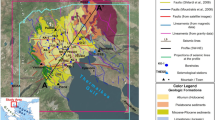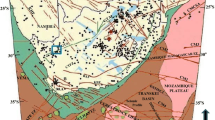Abstract
This paper presents results of multidisciplinary geochronologic, paleoseismic, and tectonophysical studies for local structures in the Sloboda tectono-dynamic intersection that is a segment of the junction between major tectonic structures in the East European Platform. These studies were conducted in the area of the Vitebsk–Surazh fault in the central part of the Sloboda intersection. This ancient long-lived discontinuity can be traced using geophysical data in the Precambrian basement. Activation during the platform phase of evolution made the fault penetrate the sedimentary deposits and form a negative flower structure showing signs of tectonic inversion. Since the Late Devonian until the beginning of the Quaternary, the Vitebsk–Surazh northeast striking fault has experienced at least two phases of tectonic activity in a setting of left lateral transpression and right lateral transtension. The Late Pleistocene to Early Holocene evolution of the Vitebsk–Surazh fault gave rise to the formation of graben-like hollows where late glacial and post-glacial lacustrine deposits were accumulated. The Gralevo Quarry shows horizons of seismites, indicators of paleoearthquakes, in the structure of these sediments. The earthquake of the highest intensity has been identified in the seismite structure of Early Holocene varved clay whose radiocarbon age is 9339 ± 36 years. The tectonophysical parameters of this seismic event are in agreement with conditions of normal-oblique deformation with a nearly east–west orientation of the tension axis and a nearly north–south orientation of the compression axis.








Similar content being viewed by others
REFERENCES
Aksamentova, N.V., Magmatizm i paleogeodinamika ranneproterozoiskogo Ocnitsko-Mikashevichskogo vulkanoplutonicheskogo poyasa (Magmatism and Paleogeodynamics of the Osnitsk–Mikashevichi Volcanoplutonic Belt), Minsk: IGN NAN Belarusi, 2002.
Aksamentova, N.V., Dankevich, I.V., and Naidenkov, I.V., The deep structure of the Belarus–Baltic granulite belt, Dokl. NAN Belorussii, 1994, vol. 38, no. 2, pp. 93–98.
Artyushkov, E.V., Geodinamika (Geodynamics), Moscow: Nauka, 1979.
Bachmanov, D.M., Kozhurin, A.I., and Trifonov, V.G., A data base of active faults for Eurasia, Geodin. Tektonofiz., 2017, vol. 8, no. 4, pp. 711–736.
Biske, Yu.S., Sumareva, I.V., and Shitov, M.V., A Late Holocene seismic event in southeastern Priladozhie. I. Principles of study and deformation structures, Vestnik SPB. Un-ta, Ser. 7, Geol., Geogr., 2009, issue 1, pp. 3–25.
Bogdanova, S.V., Segments of the East European Craton, Europrobe in Jablonna, Warszawa, 1993, pp. 33–38.
Bogdanova, S.V., Pashkevich, I.K., Gorbatchev, R., and Orlyuk, M.I., Riphean rifting and major Palaeproterozoic crustal boundaries in the basement of the East European Craton: geology and geophysics, Tectonophysics, 1996, vol. 268, pp. 1–21.
Bogdanova, S., Gorbatschev, R., Skridlaite, G., et al., Trans-Baltic Palaeoproterozoic correlations towards the reconstruction of supercontinent Columbia/Nuna, Precambr. Res., 2015, vol. 259, pp. 5–33.
Bronk Ramsey, C., Dealing with outliers and offsets in radiocarbon dating, Radiocarbon, 2009, vol. 51, no. 3, pp. 1023–1045.
Chamov, N.P., Stroenie i razvitie Srednerussko-Belomorskoi provintsii v neoproterozoe (The Structure and Evolution of the Middle Russian–White-Sea Province in the Neoproterozoic), Moscow: GEOS, 2016.
Garetsky, R.G. and Karataev, G.I., The Sloboda tectono-geodynamic intersection in the East European platform, Litasfera, 2009, no. 2, no. 31, pp. 50–66.
Garetsky, R.G. and Karataev, G.I., A tectono-geodynamic model for the junction of the Fennoscandian and the Sarmatian segment of the East European Platform, Geol. Geofiz., 2011, vol. 52, no. 10, pp. 1557–1566.
Garetsky, R.G. and Karataev, G.I., Shovnye zony Fennoskandii, Sarmatii i Volgo-Uralii (Suture Zones in Fennoscandia, Sarmatia, and Volgo-Uralia), Minsk: Belaruskaya Navuka, 2014.
Garetsky, R.G., Karataev, G.I., Astapenko, V.N., and Dankevich, I.V., The Polotsk–Kurzeme fault belt, Dokl. NAN Belarusi, 2002, vol. 46, no. 6, pp. 85–89.
Garetsky, R.G., Karataev, G.I., Golobokov, S.V., and Dankevich, I.V., The deep structure of the Central Belorussian suture zone from geophysical data, Litasfera, 2009, no. 1, issue 24, pp. 101–112.
Garetsky, R.G., Karataev, G.I., Aizberg, R.E., et al., A space-tectonic map of Belarus, scale 1 : 500 000: Development and results, Litasfera, 2013, no. 1, issue 38, pp. 3–29.
Gavrilov, Yu.O., Reflections of seismic paleo-events in the Mesozoic–Cenozoic terrigenous rock sequences in the North Caucasus, Litol. Polezn. Iskop., 2017, no. 1, pp. 1–21.
Geologiya Belarusi (The Geology of Belarus), Makhnach, A.S., Garetsky, R.G., Matveev, A.V., , Eds., Minsk: IGN NAN Belarusi, 2001.
Glubinnoe stroenie, evolyutsiya i poleznye iskopaemye rannedokembriiskogo fundamenta Vostochno-Evropeiskoi platformy: Interpretatsiya materialov po opornomu profilyu 1-EV, profilyam 4v i TATSEIS (Deep Structure, Evolution, and Mineral Deposits in the Early Cambrian Basement of the East European Platform: Interpretation of Observations at Key Line 1-EV, and Lines 4V and TATSEIS), in 2 vols., Morozov, A.F., Editor-in-Chief, Moscow: GEOKART, GEOS, 2010, vol. 2.
Elovicheva, Ya.K. and Drozd, E.N., Geologicheskie razrezy glyatsiopleistotsena i golotsena Belarusi (Geological Sections of Glacial Pleistocene and Holocene in Belarus), vol. 2, Bassein Zapadnoi Dviny (The Zapadnaya Dvina R. Basin), Minsk: BGU, 2020.
Elovicheva, Ya.K. and Sanko, A.F., Palinstratigraphy of deposits laid during the Poozerie (Vistulian) glaciation in Belarus, Litasfera, 1999, no. 10(11), pp. 18–28.
Kalicki, T., Zapis zmian klimatu oraz dzialalnosci czlowieka i ich rola w holocenskiej ewolucji dolin srodkowoeuropejskich, Warszawa: PAN IGiPZ, 2006. [in Poland].
Komarovsky, M.E. and Khilkevich, E.V., The relationship between glacial hollows and active faults in the area of Belarus, Zhurn. Belorus. Gos. Univ., Geogr., Geol., 2018, no. 2, pp. 106–117.
Kopp, M.L., Mobilisticheskaya neotektonika platform Yugo-Vostochnoi Evropy (The Mobilistic Neotectonics of Platforms in Southeast Europe), Trudy GIN RAN, No. 552, Moscow: Nauka, 2004.
Kukharchik, Yu.V., Geologiya chetvertichnykh otlozhenii (The Geology of Quaternary Deposits), Minsk: BGU, 2011.
Kolodyazhny, S.Yu., Long-lived structural complexes of the East European Platform. Article 3. The tectonics of plate covers, Izv. Vuzov, Ser. Geol. Razv., 2018, no. 4, pp. 5–16.
Kolodyazhny, S.Yu., Terekhov, E.N., Baluev, A.S., Poleshchuk, A.V., and Zykov, D.S., Tectonic features and stages of evolution of the Baltic–Mezen shear zone in the Phanerozoic, northwestern Russia, Geotectonics, 2020, vol. 54(1), pp. 1–18.
Kurlovich, D.M., Prostranstvennaya differentsiatsiya i dinamika morfostruktur Belorusskogo Poozeriya (The Spatial Differentiation and Dynamics of Morphostructures in the Belorussian Poozerie), Minsk: BGU, 2014.
Leonov, M.G. and Garetsky, R.G., The Pamir–Himalayan and the East European geodynamic intersections as areas of interaction between segments of intracontinental lithosphere, in Truggernye effekty v geosistemakh (Triggering in Geosystems), Adushkin, V.V. and Kocharyan, G.G., Eds., Moscow: GEOS, 2017, pp. 237–242.
Leonov, M.G., Morozov, Yu.A., Stefanov, Yu.P., and Bakeev, R.A., Zones of concentrated deformation (flower structures): Observations in situ and simulation results, Geodin. Tektonofiz., 2018, vol. 9, no. 3, pp. 693–720
Marrett, R.A. and Allmendinger, R.W., Kinematic analysis of fault-slip data, J. Struct. Geol., 1990, vol. 12, pp. 973–986.
Milanovsky, E.E., Geologiya SSSR (The Geology of the USSR), Part 1, Moscow: MGU, 1987.
Nagornyi, M.A., The tectonics of the Orsha Basin, Litasfera, 2009, no. 2, iss. 31, pp. 67–74.
Nesmeyanov, S.A. and Voeikova, O.A., On the problem of classification of earthquake-generating structures in the East European Platform, Byull. MOIP, Otd. Geol., 2016, vol. 91, nos. 4–5, pp. 27–39.
Obermeier, S.F., Use of liquefaction-induced features for paleoseismic analysis—An overview of how seismic liquefaction features can be distinguished from other features and how their regional distribution and properties of source sediment can be used to infer the location and strength of Holocene paleo-earthquakes, Eng. Geol., 1996, vol. 44, nos. 1–4, pp. 1–76.
Pevzner, M.M., Golotsenovyi vulkanizm Sredinnogo khrebta Kamchatki (The Holocene Volcanism at the Sredinnyi Mountain Range in Kamchatka), Trudy Geol. Inst. RAN, no. 608, Moscow: GEOS, 2015.
Poleshchuk, A.V., Zykov, D.S., and Kolodyazhny, S.Yu., On the problem of classification for earthquake-generating structures in the Baltic Shield, East European Platform, Byull. MOIP, Otd. Geol., 2020, vol. 95, no. 1, pp. 3–13.
Razlomy zemnoi kory Belarusi (Crustal Faults in Belarus), Aizberg, R.E., Ed., Minsk: Krasiko-Print, 2007.
Sanko, A.F., Neopleistotsen severo-vostochnoi Belorussii i smezhnykh raionov RSFSR (Neopleistocene of Northeastern Belarus and of Adjacent Areas of Russia), Minsk: Nauka i Tekhnika, 1987.
Sanko, A.F., Yartsev, V.I., and Dubman, A.V., Geneticheskie tipy i fatsii chetvertichnykh otlozhenii Belarusi (The Genetic Types and Facies of Quaternary Deposits in Belarus), Minsk, 2012.
Seilacher, A., Sedimentary structures tentatively attributed to seismic events, Marine Geology, 1984, vol. 55, pp. 1–12.
Seismotektonika plit drevnikh platform v oblasti chetvertichnogo oledeneniya (The Seismotectonics of Older Platform Plates in an Area of Quaternary Glaciation), Garetsky, R.G. and Nesmeyanov, S.A., Eds., Moscow: Kniga i Biznes, 2009.
Sim, L.A., The neotectonic stress fields in the east European Platform, Litasfera, 1996, no. 5, pp. 100–107.
Sim, L.A. and Marinin, A.V., Methods of field tectonophysics in the determination of paleostresses), in Sovremennaya tektonofizika. Metody i rezultaty (Modern Tectonophysics. Methods and Results), vol. 2, Moscow: IFZ, 2015, pp. 47–76.
Sim, L., Bryatseva, G., Karabanov, A., and Aizberg, R., The neotectonic stress of Belarus and the Baltic countries, Technika Poszukiwan Geologicznych. Geosynoptyka i Geotermia, 1995, vol. 34, no. 3(172), pp. 53–57.
Trifonov, V.G., Neotektonika podvizhnykh poyasov (The Neotectonics of Mobile Belts), Degtyarev, K.E., Ed., Moscow: GEOS, 2017.
Varentsov, I.M., Ivanov, P.V., Kolodyazhny, S.Yu., et al., A study of conductivity anomalies in the junction area between major segments of the East European Platform using methods of synchronous MT/MV soundings, in Voprosy teorii i praktiki geologicheskoi interpretatsii geofizicheskikh polei (Issues in the Theory and Interpretation of Geophysical Fields), Voronezh: VGU, 2020, pp. 52–56.
Vashkov, A.A., The petrographic composition of the rudaceous fraction of moraine deposits in the Gralevo quarry, in Geologiya i poleznye iskopaemye chetvertichnykh otlozhenii: materialy VIII Universitetskikh geol. chtenii (The Geology and Mineral Deposits of Quaternary Deposits: Proc. VIII Geological University Lectures), Minsk: Tsifrovaya Pechat, 2014, Part 1, pp. 6–7.
Vashkov, A.A., Zayats, Yu.I., and Zholnerovich, A.P., The geological structure and glacial morphology of the western Surazh lacustrine glacial plain, Litasfera, 2016, no. 2, Iss. 45, pp. 57–68.
Zemletryaseniya i mikroseismichnost v zadachakh sovremennoi geodinamiki Vostochno-Evropeiskoi platformy (Earthquakes and Microseismicity in Problems of Present-Day Geodynamics of the East European Platform), Book 1, Zemletryaseniya (Earthquakes), Sharov, N.V., Malovichko, A.A., and Shchukin, Yu.K., Eds., Petrozavodsk: Kar. NTs RAN, 2007.
Funding
This work was supported by the Russian Foundation for Basic Research, project nos. 18-05-00733 and 18-05-00485 in accordance with the topic of a state assignment at Geological Institute RAS.
Author information
Authors and Affiliations
Corresponding author
Additional information
Translated by A. Petrosyan
Rights and permissions
About this article
Cite this article
Kolodyazhny, S.Y., Pevzner, M.M., Poleshchuk, A.V. et al. Signs of Seismicity and Neotectonic Activity of Ancient Faults in the Area of the Sloboda Geodynamic Intersection in the West of the East European Platform. J. Volcanolog. Seismol. 15, 399–413 (2021). https://doi.org/10.1134/S0742046321060063
Received:
Revised:
Accepted:
Published:
Issue Date:
DOI: https://doi.org/10.1134/S0742046321060063




